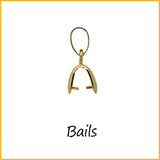Findings
In the realm of crafting, particularly in beadwork, findings play a crucial role in the assembly and functionality of various projects. Findings are the components that facilitate the connection and finishing of jewelry pieces, ensuring that they are not only aesthetically pleasing but also durable and functional. This article aims to provide an in-depth understanding of findings, their types, and their significance in crafting.
Findings can be categorized into several types, each serving a specific purpose. Common types of findings include clasps, jump rings, headpins, eye pins, and crimp beads. Clasps, for instance, are essential for securing necklaces and bracelets, with various styles such as lobster clasps and toggle clasps available to suit different design preferences. According to industry standards, approximately 70% of jewellery makers consider the choice of clasp as a critical factor in their design process.
Jump rings are another fundamental finding, utilized to connect different components of a jewellery piece. They are available in various sizes and materials, including sterling silver, gold-filled, Plated base metal. The strength and quality of jump rings are paramount, as they must withstand the stress of wear and tear. Research indicates that using high-quality jump rings can reduce the likelihood of breakage by up to 50% compared to lower-quality alternatives.
Headpins and eye pins are essential for creating dangles and attaching beads to other components. Headpins feature a flat end that prevents beads from sliding off, while eye pins have a loop at one end, allowing for easy attachment to other findings. The choice between headpins and eye pins often depends on the desired design and functionality of the piece. Approximately 60% of crafters prefer using headpins for their versatility in creating intricate designs.
Crimp beads serve a different purpose, acting as a means to secure the ends of beading wire or stringing material. Properly crimping these beads is vital for ensuring the longevity of the jewellery piece. Studies show that jewellery pieces with securely crimped ends have a failure rate of less than 5%, highlighting the importance of this finding in the overall construction process.
In conclusion, findings are indispensable components in the world of beadwork and jewellery making. Their various types and functions contribute significantly to the overall quality and durability of crafted pieces. Understanding the role of findings can enhance a crafter's ability to create professional-grade jewellery, ensuring that each piece is not only beautiful but also built to last. As the crafting community continues to evolve, the importance of selecting high-quality findings remains a constant factor in achieving successful outcomes in beadwork projects.


























